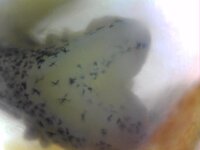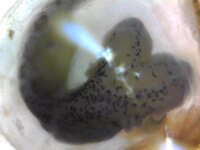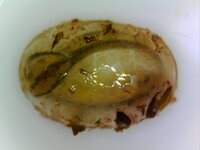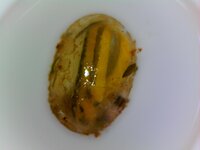NKmememachine
New member
Hey everyone, I just thought I'd share two of the more interesting things I have come across while keeping and breeding alpine newts. I've only had two batches of eggs and already I have come across some crazy stuff. I also have a microscope attatchment for my computer so I was luckily able to photograph these.
The first batch of eggs a couple of years ago had what appeared to be a two-headed embryo, or I guess conjoined twins? The egg hatched but it didn't survive very long so I never saw it get big enough to tell exactly what was going on, but I'll upload the picture and maybe someone on here knows more.
The second batch of eggs that I am currently rearing seems to have two embryo's growing in one egg! It doesn't seem to be a case of two eggs growing close together or attactched or anything like that, but rather one egg membrane with two embryos developing next to each other. I am assuming that these formed from the same egg and simply split like how the process for identical twins works in humans. However is it possible that two eggs were deposited with one membrane? In the pictures of the egg of two embryos, the second one is a bit hard to see since it's not a very clean egg but it is visible below the first one.
For anyone with more knowledge or experience on the topic, how common are these situations? Is this case caused by the same or similar mechanisms that caused the previous case from the last batch? I vaguely remember hearing somewhere that early damage to the egg can cause stuff like this. I know that the moms aren't always that careful when depositing and covering the eggs. If this is the case is there a way to prevent any further abnormalities? (I'm hoping the two embryos in this second case survive but I really don't want any of my animals suffering from future problems). I've also encountered a few of what's commonly called "spinners" on this forum, but I've heard that those are unfortunately somewhat common and a few can be expected in each batch.
Anyway I thought these two cases were interesting and worth sharing. If anyone here wants any updates on the "twins" I'd be happy to report on whether or not they survive long term and how they turn out!
P.S. I might be putting some of the hatchlings from this curent batch for up sale on this forum later if all goes well!
The first batch of eggs a couple of years ago had what appeared to be a two-headed embryo, or I guess conjoined twins? The egg hatched but it didn't survive very long so I never saw it get big enough to tell exactly what was going on, but I'll upload the picture and maybe someone on here knows more.
The second batch of eggs that I am currently rearing seems to have two embryo's growing in one egg! It doesn't seem to be a case of two eggs growing close together or attactched or anything like that, but rather one egg membrane with two embryos developing next to each other. I am assuming that these formed from the same egg and simply split like how the process for identical twins works in humans. However is it possible that two eggs were deposited with one membrane? In the pictures of the egg of two embryos, the second one is a bit hard to see since it's not a very clean egg but it is visible below the first one.
For anyone with more knowledge or experience on the topic, how common are these situations? Is this case caused by the same or similar mechanisms that caused the previous case from the last batch? I vaguely remember hearing somewhere that early damage to the egg can cause stuff like this. I know that the moms aren't always that careful when depositing and covering the eggs. If this is the case is there a way to prevent any further abnormalities? (I'm hoping the two embryos in this second case survive but I really don't want any of my animals suffering from future problems). I've also encountered a few of what's commonly called "spinners" on this forum, but I've heard that those are unfortunately somewhat common and a few can be expected in each batch.
Anyway I thought these two cases were interesting and worth sharing. If anyone here wants any updates on the "twins" I'd be happy to report on whether or not they survive long term and how they turn out!
P.S. I might be putting some of the hatchlings from this curent batch for up sale on this forum later if all goes well!
Attachments
Last edited:




